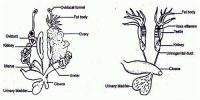As a result of the entrance of air inside the lungs the air of the lungs gets oxygen. The moist vapor that remains in this reaches to the interior part of the alveoli. Oxygen dissolves in watery drops a result the volume and pressure of oxygen increase. At this time the volt and pressure of oxygen in the blood of capillaries on the body walls of alvi remain less. As a result oxygen enters the blood through diffusion process. this time oxygen combines with the haemoglobin of blood, to form compound known as oxyhaemnglobin.
Haemoglobin + Oxygen —> Oxy-haemoglobin.
This oxygen enriched blood reaches the body cells through the heart. The volume and pressure of oxygen remain less in the body cells, so breaking the oxyhaemoglobin the oxygen separates and enters the cells. This oxygen oxidizes the simple food (glucose) of the cells and produces energy. Oxy-haemoglobin = Haemoglobin + oxygen.
Glucose oxidation and energy production: This stage of internal respiration occurs in two steps.
- Glycolysis
- Kreb’s cycle
Glycolysis: This process occurs in the cytoplasm of the cell. At this stage oxygen is required. At this time one molecule of glucose breaks into two molecules of pyruvic acid.
I Molecule of glucose = 2 molecules of pyruvic acid.
Kreb’s cycle: This process occurs in the mitochondria of the cell. The enting process is completed by certain steps and in the presence of some specific enzymes. At this stage oxidation occurs in the presence of oxygen. As a reesult carbon-dioxide, water and energy are produced.














